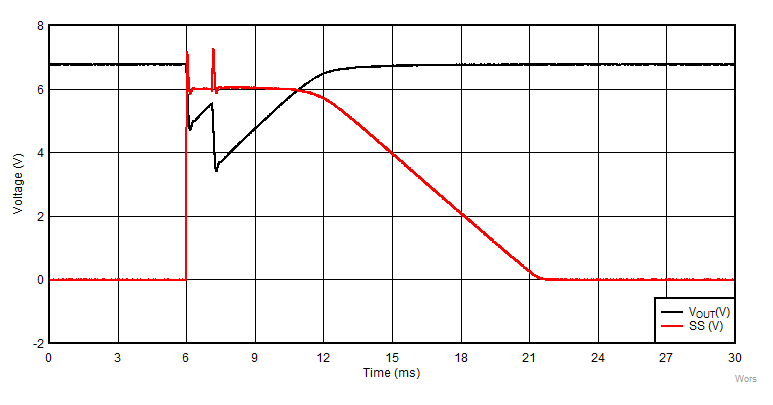SLVAE32B August 2018 – December 2023 TPS7H2201-SP
- 1
- Abstract
- Trademarks
- 1 Device Overview
- 2 Single-Event Effects
- 3 Test Device and Evaluation Board Information
- 4 Depth, Range, and LETEFF Calculation
- 5 Irradiation Facility and Setup
- 6 Test Setup and Procedures
- 7 Single-Event-Latchup (SEL), Single-Event-Burnout (SEB), and Single-Event-Gate-Rupture (SEGR)
- 8 Single Event Transient (SET)
- 9 Total Ionizing Dose From SEE Experiments
- 10Orbital Environment Estimations
- 11Confidence Interval Calculations
- 12Summary
- 13References
- 14Revision History
8 Single Event Transient (SET)
SET testing was performed at room temperature, with141Pr with an angle of incidence of 27.3° die for a LETEFF 75 MeV × cm2/ mg. The VIN was set to maximum (7-V) and minimum (1.5-V) recommended voltages at maximum load of 6-A and no load. Under these conditions, the die temperature is around 33 °C when loaded to 6-A and 23°C when not loaded. Flux of approximately 105 ions /cm2× s and fluence ≥ 1× 107 ions / cm2 were used in each run. The device was also evaluated when the DUT was disabled by using the EN (0-V) and the OVP (1-V) pins by forcing an external voltage into the pins. Not a single upset on Vout or SS was observed during the SET testing at room temperature. A window trigger with ±3% around the output nominal voltage (when the device was enabled) and a ±200 mV (when the device was disabled) was used for the detection of upsets during the characterization.
During the SEL testing, when the device was exposed to a die temperature of 125°C, upsets that create a momentary Soft Start (SS) cycle were observed. Table 8-1 lists the test conditions and results for the SET testing of the TPS7H2201-SP. Worst case observed transient (SET) for VOUT and SS is shown in Figure 8-1.
The SET cross-section was calculated observed 95% (2σ) confidence interval and combining (or summing) fluences (see Section 11 for discussion of confidence limits). The cross section is classified by die temperature and LETEFF.
| Run Number | Unit Number | Temperature (°C) | Ion Type | Angle of Incidence (°) | LETEFF (MeV × cm² / mg) | Flux (ions / cm² × s) | Fluence (ions / cm2) | VIN (V) | Load | Enabled? | SET Events |
|---|---|---|---|---|---|---|---|---|---|---|---|
| 8 | 3 | 33 | Pr | 27.3 | 75 | 9.94 × 104 | 2 × 107 | 7 | 6 | Yes | 0 |
| 9 | 3 | 33 | Pr | 27.3 | 75 | 9.97 × 104 | 2 × 107 | 7 | 0 | Yes | 0 |
| 10 | 4 | 33 | Pr | 27.3 | 75 | 1.01 × 105 | 2 × 107 | 1.5 | 6 | Yes | 0 |
| 11 | 4 | 33 | Pr | 27.3 | 75 | 1.09 × 105 | 2 × 107 | 1.5 | 0 | Yes | 0 |
| 12 | 3 | 33 | Pr | 27.3 | 75 | 1.04 × 105 | 2 × 107 | 7 | 6 | No | 0 |
| 13 | 5 | 33 | Pr | 27.3 | 75 | 7.99 × 104 | 1.36 × 107 | 7 | 6 | No | 0 |
| 14 | 5 | 33 | Pr | 27.3 | 75 | 8.53 × 104 | 1 × 107 | 1.5 | 6 | No | 0 |
| From SEL Runs | |||||||||||
| 1 | 1 | 125 | Pr | 27.3 | 75 | 1.07 × 105 | 2 × 107 | 7 | 6 | Yes | 396 |
| 2 | 1 | 125 | Pr | 0 | 66.43 | 1.14 × 105 | 9.96 × 106 | 7 | 6 | Yes | 5 |
 Figure 8-1 Worst Case Overlay of
VOUT and SS SET for Run 1 at LETEFF 75 MeV ×
cm2 / mg and T = 125°C
Figure 8-1 Worst Case Overlay of
VOUT and SS SET for Run 1 at LETEFF 75 MeV ×
cm2 / mg and T = 125°C